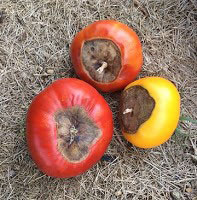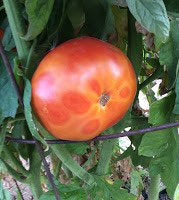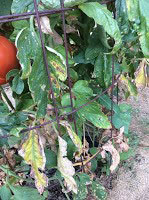Adapted from the CO-Horts blog originally authored by Jane Rozum, Douglas County.

Blossom end rot |
|
|

Tomato Spotted Wilt Virus (TSWV) |
Tomatoes may have many different problems during the growing season. Depending on the symptoms, a gardener can diagnose issues with plants so decisions can be made on the best course of treatment. Tomatoes may have problems based on nutrient, environmental and biotic issues. A list of these issues and possible causes are itemized below.
Nutrient or environmental problems:
- No blossoms or blossoms do not result in fruit: temperatures too hot or cold during blossom set; excessive nitrogen fertilization
- Stunted plants early in the season, purple veins in leaves: Phosphorus deficiency
- White, leathery areas on fruit: Sunscald
- Black/Brown sunken areas on blossom end of fruit: Blossom end rot caused by inconsistent watering or calcium deficiency
- Misshapen fruit with scars or holes on blossom end of fruit: Catfacing
Fungal, bacterial, viral problems:
- Brown leaf spots on older leaves near to bottom of the plant: Early blight
- White/gray spots on leaves surrounded by black or brown margin: Septoria leaf spot
- Yellowing of older leaves, leaves may turn brown/black and wilt: Fusarium wilt
- Yellow or orange rings on fruit; distorted leaves with purple veins and stems have sunken cankers: Tomato Spotted Wilt Virus (TSWV)
- Lower leaves turn down, leaf edges brown. Small white/yellow raised blotches on fruit: Bacterial spot
Insect problems:
- Leaves stripped off plant; large, green caterpillars present on plants: Tomato hornworms
- Leaves turn purplish yellow; white crystals resembling sugar or salt on leaves: Psyllids
- Dark pinpricks on green fruit, surrounded by discolored area: Stink bugs
- Leaves have holes or pits, small dark-colored beetles present: Flea beetles
- Honeydew produced and insect present: Whiteflies or Aphids
Not all tomato plant injury can be attributed to the above problems. Herbicide injury may cause stunted, curling and cupping of leaves.
For more information on tomato problems, please see the following publications:
Planttalk Colorado™ Scripts:
- Planttalk #1458, Psyllids
- Planttalk #1471, Blossom End Rot
- Planttalk #1836, Don’t Over-Winter Vegetable Diseases and Insects
YouTube Video
CSU Extension Fact Sheets
Photos taken by J. Rozum




